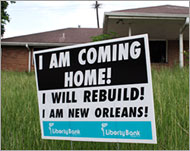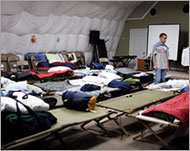New Orleans’s development dilemma
As Hurricane Katrina’s one-year anniversary approaches, officials in battered New Orleans are pressing ahead with ambitious development and crime-busting plans, hoping to lure tourist dollars to the city.

Two months ago, on 15 June, George W Bush, the US president, signed the long-awaited emergency relief bill for the region, which will release billions in federal spending for redevelopment of New Orleans.
Still, local officials have not come up with a plan for rebuilding the city. Neighbourhoods have not been approved or denied, no matter the level of danger or damage, and new housing structures to replace those ridden with toxic mould have not been designed.
Recently re-elected New Orleans mayor, Ray Nagin has been criticised for dragging the plans and for publicly heralding New Orleans’s reconstruction efforts without a solid vision.
On 16 June, Nagin, ignoring the plight of homeowners and renters in NOLA, announced an expansion of casino gambling on Canal Street, along the border of the famous French Quarter.
“We will probably limp along for the next three to five years unless we do something bold. And to me, this is a bold statement,” he said.
In response to the mayor’s proposal, Kathleen Blanco, the Louisiana governor, issued a statement assuring her collaboration with city officials to rebuild New Orleans, but included: “I urge caution in looking to the expansion of gambling as a quick-fix to our economic problems in the city.”
Currently, only Harrah’s Entertainment, the Las Vegas casino operator, may operate legally within the city, a deal which provides New Orleans $15 million yearly in tax revenue from the city’s one land-based casino.
Although Harrah’s has exclusive rights, they are willing to hear what Mayor Nagin and other officials have to say.
Louisiana’s Las Vegas?
The proposed plan states that casinos would be placed within only those major hotels with more than 500 rooms.
Hotel operators, meanwhile, are trying to keep their priorities in line. The owner of the Hyatt Regency New Orleans, Laurence Geller, affirms that Nagin has a bold vision, but asks the city to focus on rebuilding infrastructure first.
State officials are hesitant about the plan, and are requesting more in-depth planning. New Orleans’s citizens are not enthusiastic.
“Nagin wants to turn this city into another Las Vegas,” hotelier student Josh Bourgeois told Aljazeera.net.
“New Orleans is already expensive, and economically closed off to probably half of the people who lived here before Katrina hit.”
Residents, some who have returned and many others who have not, are troubled by the city’s housing emergency and disorganisation, including rising rent, lack of suitable and safe housing, and little public assistance to gut and clean homeowners’ properties.
|
“[Mayor Ray] Nagin wants to turn this city into another Las Vegas” Josh Bourgeois, |
Curtis Muhammad, director of the People’s Organising Committee in New Orleans, believes “officials want to make New Orleans a city for tourists, with the absence of poor black people”.
In the aftermath of Hurricane Katrina, the city stands to lose up to 80% of its African American population, the majority of whom are renters.
Whether having sustained damage to their rented homes and apartments or not, these people must now leave, as the city has decided to “rebuild” rental property, demolishing it with few considerable replacements.
Redevelopment
The Federal Department of Housing and Urban Development (HUD) announced in late June that 5,700 public housing apartments are to be razed and replaced with 2,000 mixed-income units, forcing almost 4,000 low-income, mostly black, families to relocate.
The number of displaced people will likely be more, as the new housing developments will not be as affordable as the existing structures.
Urban planners and city officials believe this is a move in the right direction for the future of New Orleans.
HUD’s Office of Field Policy and Management refused to discuss their plans for the housing developments, and fielded all questions to the Housing Authority of New Orleans (Hano).
Adonis Expose, Hano’s public information officer, revealed the housing developments’ timeline to be 24-36 months for demolition and re-occupancy.
For those 3,700 families who will not be placed in the new mixed-income housing units, Expose states: “Hano is issuing Section 8 vouchers, and has increased fair market rents by 35% in order to attract more landlords, making more rental homes open to Section 8 residents.
 |
|
Little by little, people are coming |
“The population of African American families is not what it was before Katrina, but as time goes on, more people and different economic classes will come back. It will be way more than we are expecting. Housing is an issue around the city.”
Hard hit
Hurricane Katrina first hit land in southern Florida as a moderate Category 1 storm, before moving into the Gulf of Mexico and gathering force. By the time Katrina hit land again in southeast Louisiana on 29 August, it was one of the strongest recorded hurricanes in the Gulf’s history.
Some 80% of New Orleans was flooded during the storm, mainly due to sinking land and poor structural quality of the levees surrounding the city, separating New Orleans proper from the Mississippi River and Lake Pontchartrain.
Thousands of lower and middle-class African American families were left to fight the floodwaters, huddled on rooftops and dodging bullets.
Pamela Mitchell-Lewis, 48, a resident from 9th Ward New Orleans East, faced a harrowing ordeal trying to evacuate from the city: “I picked up this old broken boat from the street and pulled everyone to safety, my two nieces, my 86-year-old mother, our elderly neighbour, and my daughter.
“By the time we got to Orleans Avenue, close to Crescent City where they closed all those projects, the Sheriff’s Department pulled out their AK-47s and heavy artillery, and told us to get our asses back across the water. That was on August 29th. I had to push everyone back across the bridge.”
Pushed Out
Amid the stark reality of the hurricane’s aftermath – hundreds of abandoned homes, many of them never returned to and still holding the decaying effects of the people who left nearly a year ago – are the now-abandoned projects, slated for demolition.
In the Lafitte Housing Development, doors and windows are riveted shut with grey metal sheets, the waterlines of the city’s flooding well below the doors to the first floor apartments.
Evidence of family possessions – curtains, bottles, dried plants, and books – can still be seen in the windows of the second and third storeys.
|
|
|
Some still live in basic |
Despite the lack of visible wind or flood damage to these facilities, military and government officials made it top priority to board up the sprawling complexes during the first week of October, as they simultaneously registered thousands of displaced people into trailer parks run by the Federal Emergency Management Agency (Fema) across the state.
Fema, a federal agency, funds its activities through the tax dollars of Americans nationwide. This includes the housing of the displaced residents of these closed projects, even though their homes were not destroyed by Hurricane Katrina. These residents are in fact victims of city economic policy.
Residents fighting back
While the city has undertaken public housing renovations in the past, state and local officials have not tried to hide building demolition and displacement of project tenants, by passing them off as hurricane victims.
Representative Richard H Baker, a Republican from Baton Rouge, said just after the hurricane: “We finally cleaned up public housing in New Orleans. We couldn’t do it, but God did.”
Residents have been fighting back. Since June 3, over 300 former residents banded together to create the Survivor Village Tent City on St Bernard Avenue, in the neutral ground of the road’s median.
In July, members of Survivor Village marched down St Charles Avenue, raising awareness for the struggle to regain entry to their homes, scheduled to soon be demolished by federal and local officials HUD and Hano.
Protesters distributed mock eviction notices to upper-class residents along St Charles Avenue, demonstrating their efforts to protect their homes. The citations read:
Notice to Evacuate. Applicable to the properties of the Garden District … these dwellings, which house single families on lots that could house several families, will be renovated to provide mixed-income homes.
Another survivor stated: “The people of New Orleans will not go quietly into the night, becoming the homeless of countless other cities.”
All photographs by Jennifer Warren
